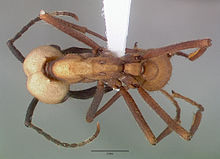Eciton burchelli
| Eciton burchelli | ||||||||||||
|---|---|---|---|---|---|---|---|---|---|---|---|---|

Eciton burchelli |
||||||||||||
| Systematics | ||||||||||||
|
||||||||||||
| Scientific name | ||||||||||||
| Eciton burchelli | ||||||||||||
| Westwood , 1842 |
The scientific name of the species is very often written " burchellii ", which corresponds to the original Westwood spelling.
Eciton burchelli is a type of predatory wandering ants from the subfamily Ecitoninae that is common in the New World . It is one of the best-researched species in its genus.
description
Eciton burchelli is polymorphic, i.e. This means that their individuals can vary in size and shape. The caste of workers in a colony have an average size between three and twelve millimeters, with each caste having its own special area of responsibility. The soldiers form sickle-shaped mouthparts and are characterized by a pronounced head. The long legs give the species a spider-like habit, which is reinforced by its fast running characteristics. The color varies depending on the habitat from light brown, slightly transparent gold, reddish orange to dark brown. Workers have greatly reduced complex eyes with only one facet, a double segmented waist and a thorn-shaped appendage. Their legs are provided with hooks, with the help of which they can build bridges and mobile bivouacs with other conspecifics.
Occurrence
E. burchelli is a widespread ant species and occurs in tropical Central and South America . The species is represented from Mexico to Brazil .
Way of life
The species is the dominant species of the genus Eciton and is characterized by its typical raids. Their colonies are quite large and can contain between 100,000 and 2,000,000 adults. Each colony consists of a queen, brood or larvae and the majority of workers. If the colony exceeds a certain size, further offshoot colonies are created by colony division (called hesmosis). On their mostly aboveground forays, workers often form living bridges to overcome obstacles and ensure a high walking speed. In contrast to E. hamatum, swarming is their preferred hunting tactic on a broad front. From the main direction of travel, several attack trains feel their way towards a broad swarm front. The concentration of women workers and soldiers is ahead. These forays have a duration of eleven to twelve hours, with the captured food being transported back to the bivouac by the workers. Using computer models and the Fisher equation, an attempt was made to mathematically reproduce the swarm behavior of E. burchelli by analyzing the pheromone-marked walkways. Their food spectrum includes u. a. Insects and smaller vertebrates. E. burchelli ants are considered to be outspoken generalists. Their forays are often accompanied by ant birds and woodpeckers, which catch animals fleeing from the ants. In the life cycle of E. burchelli, the stationary phase lasts approx. 19–22 days and the nomadic or migration or wandering phase approx. 11–16 days. During the hiking phase, they often set up their bivouacs in hollow tree trunks up to about three meters high. Although they are occasionally found on agricultural land, E. burchelli prefers wooded areas. Their communication is achieved through chemical signals.
literature
- N. Franks: Ecology and Population Regulation in the Army Ant Eciton Burchelli. Pp. 389-403 in The Ecology of a Tropical Forest. United States of America: The Smithsonian Institute, 1982
- Teresa Mikelson & Laura Patrick: Foraging Behaviors of Army Ants (Eciton burchelli), Biology Paper Abstracts, Journal of the Idaho Academy of Science 2001
Web links
- Sean O'Donnell & Robert L. Jeanne: Notes on an Army Ant ( Eciton burchelli ) Raid on a Social Wasp Colony ( Agelaia yepocapa ) in Costa Rica , Journal of Tropical Ecology, pp. 507-509, 1990
- New World Army Ants: Eciton burchelli (at arkive.org)
- José Almora, Albert Izarraraz, Qiao Liang and Crystal Nesmith: Agent based modeling of Eciton burchelli swarm patterns , Mathematical and Theoretical Biology Institute of Arizona State University, online: PDF
Individual evidence
- ↑ Archive link ( Memento of the original dated May 31, 2013 in the Internet Archive ) Info: The archive link was inserted automatically and has not yet been checked. Please check the original and archive link according to the instructions and then remove this notice.
- ↑ Albert Izarraraz, Qiao Liang and Crystal Nesmith: Agent based modeling of Eciton burchelli swarm patterns, Mathematical and Theoretical Biology Institute of Arizona State University
- ↑ http://www.ameisenforum.de/artbeschreibung-steckbriefe/31079-eciton-burchelli.html
- ↑ http://animaldiversity.ummz.umich.edu/site/accounts/information/Eciton_burchelli.html



